
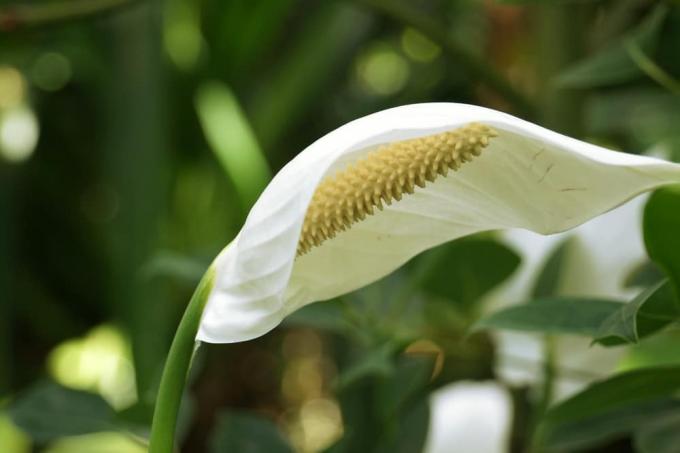
Table of contents
- Short profile
- Location
- lighting conditions
- substrate
- Demands on the plant pot
- pouring behaviour
- Fertilize
- Cut
- repot
- Methods of Propagation & Rearing
- Worth knowing about the flower
- hibernate
- diseases and pests
Peace lily, sheath-leaf or single-leaf, Spathiphyllum goes by many names. Nevertheless, a single petal is enough for the houseplant to create a cozy and at the same time stylish atmosphere. In addition, the popular plant proves to be extremely undemanding. Nevertheless, it requires an appropriate location and a few care measures from the owner. The tips in this guide will make cultivation a breeze.
Short profile
- belongs to the arum family (Araceae)
- contains toxic plant juices
- comes from the tropical regions of America
- now also occurs as a natural wild plant in Europe
- elegant ornamental plant in different varieties
- Growth height varies from variety to variety between 20 and 120 cm
- grows perennial
- blooms white in spring and late summer
- Name derives from the appearance of the flower
- filters pollutants from the air, ensures a better indoor climate
- but can also cause allergic reactions
Location
The sheath leaf comes from the tropics and therefore only feels comfortable in high humidity. The location should be warm and humid. If the temperatures fall below 15°C, the decorative plant loses its charm. The peace lily only accepts temperatures of around 12°C at night. The humidity is at best 60 to 75%. If the selected location does not meet this requirement, the breeder can help with various measures:
- Spray leaves regularly with low-calcium water (especially in winter when the heating air is warm)
- Place the plant in a saucer filled with water and pebbles (roots must not hang in the water)
- Place the plant next to an indoor fountain
- combine with other aquatic plants if necessary
Air that is too dry is noticeable by brown shoot tips and increases the risk of pest infestation.
lighting conditions
Not only the elegant appearance makes Spathiphyllum a popular houseplant. A great advantage of the scabbard blade is its adaptability to dark locations. Although the plant grows a little more slowly in shady corners of the room, it can still be cultivated here without any problems. Of course it should be noted. that every crop needs some light to develop. If necessary, the breeder fulfills this requirement with artificial lighting. In addition, this measure visually creates a sophisticated atmosphere. Irradiation should not exceed 500 lux.
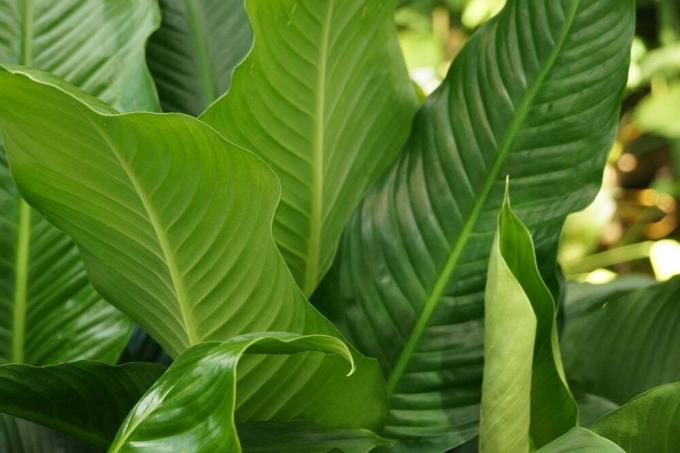
Since Spathiphyllum thrives in its tropical home on the shady soil of the jungle, the plant does not tolerate direct sunlight. In general, only three to five hours of sunshine per day are recommended. If you still want to place your plant by the window, you should adhere to the following distance recommendations:
- north orientation: directly on the windowsill
- west or east orientation: 2 to 3 m distance
- southern orientation: 3 to 4 m distance
Tip:
The single sheet is wonderfully kept in bathrooms. Humidity is usually high here. Darkened bedrooms are also a suitable location. The owner should cultivate the plant out of the reach of children and pets as it contains toxic substances.
substrate
The sheath leaf prefers loose, well-drained soil. A pH value of 5 to 6 in the slightly acidic range is considered optimal. Under no circumstances should the substrate contain salt. The houseplant is even satisfied with conventional potting soil. In this case, the gardener should definitely set up a drainage made of shards, pumice or gravel. Ideally, however, he mixes the substrate himself:
- 5 parts good quality potting soil or compost
- 1.5 to 2 shares of arable soil with clay
- 1 portion quartz sand
Tip:
To make sure that the substrate that you have mixed yourself has the right pH value, the gardener should check the acidity with a test strip from a specialist shop.
Demands on the plant pot
The peace lily hardly takes up any space. A small planter is sufficient. With a diameter of 20 cm, the maximum volume has already been reached. Basically, the breeder can continue cultivating the plant as he buys it commercially. If you don't already have one, you should definitely install drainage. This even makes it possible to keep them as hydroponics.
pouring behaviour
The sheath blade has a comparatively high water consumption. Constant, even watering is therefore recommended. The substrate must not dry out under any circumstances. It is best for the gardener to water the plant as soon as the top layer of soil has dried. Drainage helps against impending waterlogging.
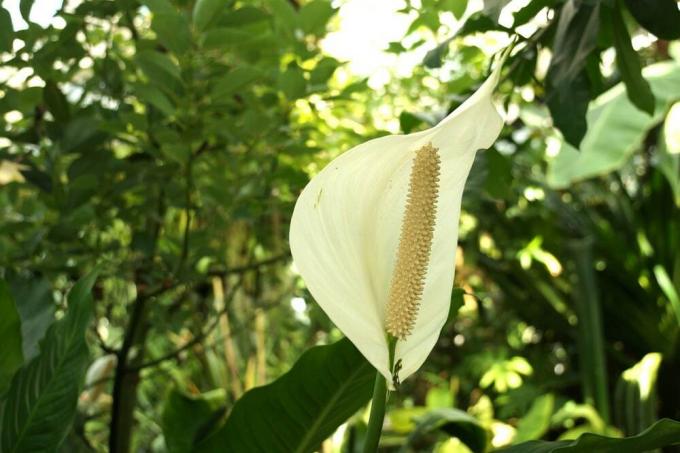
In addition, the watering quantity depends on the location factors. The need for water increases in bright and warm rooms. About twice a week watering is required here. The single leaf needs a little less liquid in the winter months. Then watering every 14 days is sufficient. The gardener should always use low-lime water for this. If you are undecided about the watering quantity and intensity, use the appearance of the sheath blade as a guide.
Drooping leaves are a clear sign of a lack of water. Interesting to know: Since floods are not uncommon in the Amazon, the peace lily can even survive completely under the water surface for a short time.
Fertilize
After about six to eight weeks, Spathiphyllum has withdrawn almost all nutrients from the substrate. During the flowering phase, the breeder can therefore help with a liquid complete fertilizer. To promote growth, he administers the nutrients every 14 days. In autumn and winter, however, fertilizing is not necessary.
An exception is a warm location. In this case, however, a single nutrient supply per month is sufficient. The plant draws attention to a too high dose with brown speckles on the leaves. Furthermore, it is advisable to first water the substrate before the grower applies the fertilizer. Since the sheath leaf is very sensitive to salt, it is important that the fertilizer is well distributed in the substrate.
Cut
A pruning is not necessary for the houseplant. The gardener should only make a few shaping corrections if the plant grows too bushy. But it is better to divide the plant (see below). If you still prefer to use scissors, proceed as follows:
- Remove brown leaf tips
- cut off dried leaves
- remove faded flowers
- cut off rotting roots
A notice:
The gardener cuts wilted flowers as far down the shoot as possible. Restraint is also out of place when it comes to roots. Here he can confidently cut back to the white.
repot
How often the grower repots the single leaf depends on site factors. Since the plant grows faster in bright places, he should carry out this care measure under these conditions every year. Otherwise, a rhythm of three years is usually sufficient, unless the pot is visibly too small. Spring is the best time to repot Spathiphyllum. Since the roots heal best at this time, it is advisable to divide the plant at the same time. Depending on the size of the root ball, far more than ten new plants can develop.
- dig up leaf
- Remove soil from root ball
- cut with a sharp knife
- Fill pots with universal or anthurium soil
- Put the pieces back into separate pots
A notice:
The Peace Lily is extremely easy to divide, so most of the time no tools are required. It is often possible to tear the root ball apart with your bare hands. If fine roots break off, the plant is not damaged.
Methods of Propagation & Rearing
cutting
If the grower gets a rootless shoot when dividing, he simply puts it in a container of fresh water. Fine root strands soon form and he can plant the cuttings in the ground.
seed
In addition, cultivation from seeds is possible. The procedure itself does not require much effort. The gardener needs loose potting soil and must ensure high humidity at around 25°C. Acquiring the seeds is much more difficult. Even in well-stocked specialist shops, he rarely finds what he is looking for. The chances of success are highest on the Internet. Obtaining the seeds from your own plants requires a great deal of skill. Several cultivations are necessary for this procedure. In addition, it is necessary to pollinate the plants by hand.
A notice: After the gardener has planted a cutting of the peace lily, it should be allowed about three months before the first fertilizing.
Worth knowing about the flower
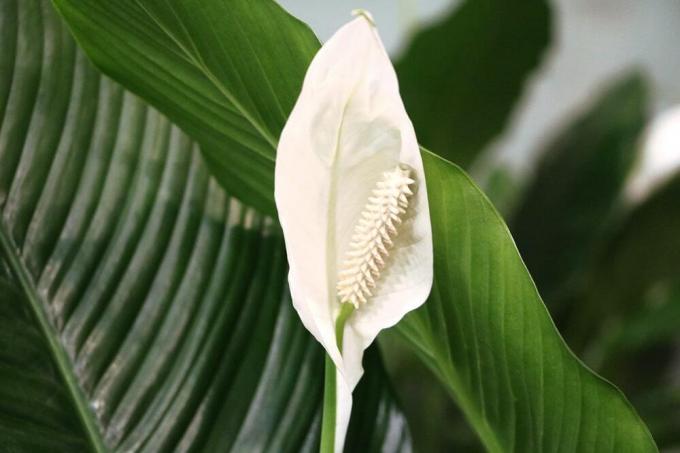
The radiant white of the blossom of the single leaf only lasts about a week. The hue then changes to a light green. In this state, the sheath leaf blooms for a full two months. After a three-month break, the buds appear again. By intentionally damaging the flower slightly, the gardener stimulates its growth.
A notice:
Most commercially available sheath leaves bloom continuously, since it is now known how the flowering time can be specifically influenced.
hibernate
Even in winter, the temperature should not fall below 15°C. In a warm environment, the growth of the single leaf remains unchanged. If you want to keep the maintenance effort as low as possible, you can store the plant at around 16°C. Then it has a lower water requirement. In addition, the gardener can reduce the humidity a little at low temperatures.
diseases and pests
Unfortunately, mites often seek out houseplants. Above all, the spider mite is considered a typical pest. The parasite is easily recognized by the cobweb-like formations on the shoots. In closed rooms there are hardly any possibilities to actively fight the infestation. Since the spider mite usually appears when the air is too dry, it helps to regularly spray the plant with water. If the little animals become visible on the leaves, they can be wiped off with a cloth. Chemical agents are not an alternative as they do more harm than good to the crop.
 garden editorial
garden editorial I write about everything that interests me in my garden.
Learn more about Exotic Plants
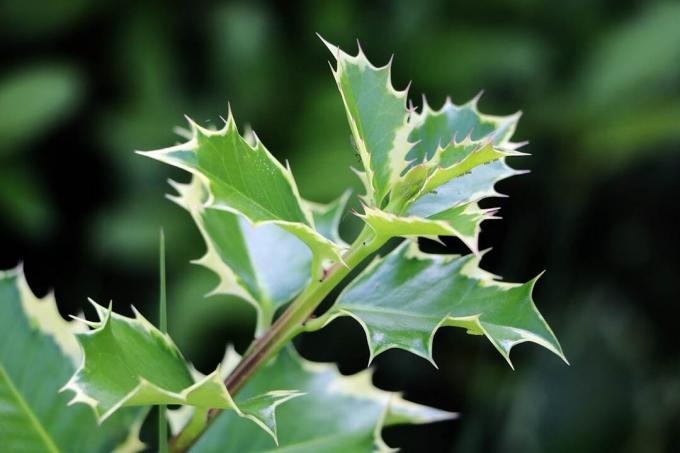
Holly, holly: care from A to Z
The European holly is one of the evergreen plants. It reaches a height of up to five meters and is ideal as a Christmas decoration or garden shrub. The native, although rarely occurring plant is the only native representative of the Ilex family and is particularly easy to care for and robust.
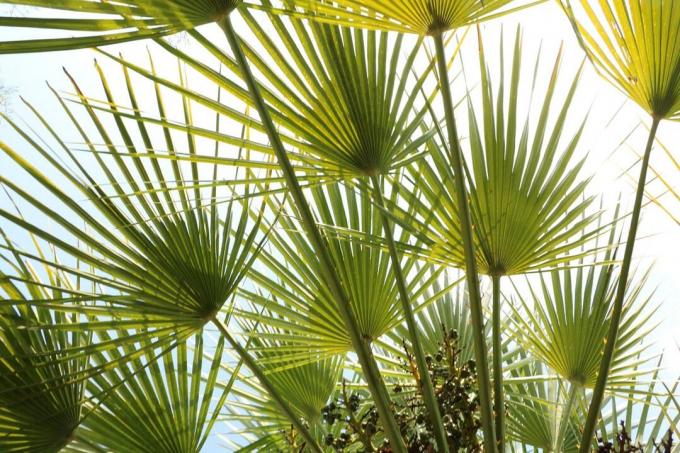
Dwarf palm, Chamaerops humilis: care instructions
The dwarf palm remains small enough that it can also be cared for in the room. However, it also cuts a fine figure in the garden. You can find out here how it is maintained and what needs to be considered.

Dwarf date palm, Phoenix roebelenii: Care from A-Z
The dwarf date palm (Phoenix roebelenii) is a particularly small, actually the smallest palm species of its genus. But that doesn't make them any less decorative. It is the most filigree and elegant date palm and hardly grows higher than one meter.

Growing vanilla plants: 11 tips for care
The vanilla plant is truly exotic in Central Europe and cannot be found in every garden. Vanilla planifolia forms the aromatic pods for which the plant is known. The cultivation of a vanilla plant is easily possible with the right care tips.

Kangaroo Paw: Caring for the kangaroo plant
Kangaroo paws are exotic plants native to southwestern Australia. Considering the care instructions, Kangaroo Paw can also thrive in Central European conditions. Maintenance requires a little more effort. If the plant gets enough attention, it will thank you with magnificent inflorescences.

9 psychoactive & hallucinogenic plants in the garden
Even in this country psychoactive and hallucinogenic plants grow, many of them even in the local gardens. However, the herbal ingredients of domestic natural drugs are often characterized by a high toxic potential. Therefore, severe poisoning often occurs after consumption.



